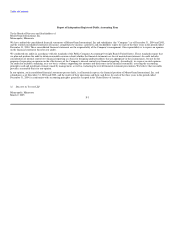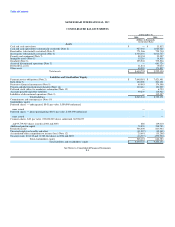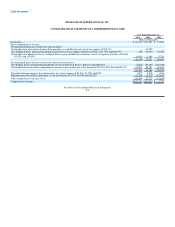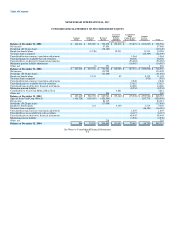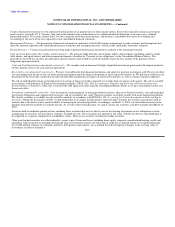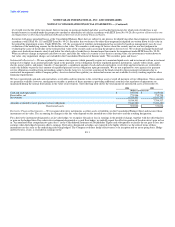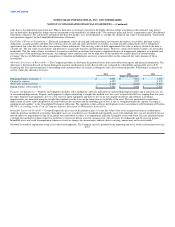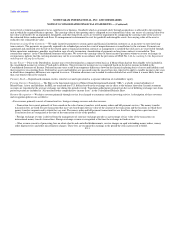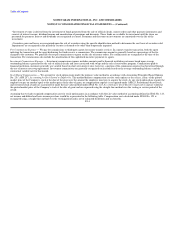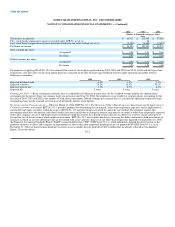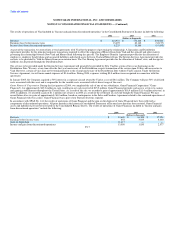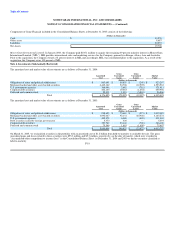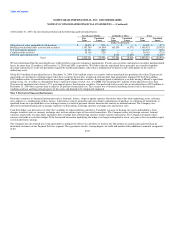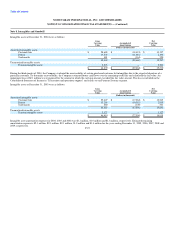MoneyGram 2004 Annual Report Download - page 57
Download and view the complete annual report
Please find page 57 of the 2004 MoneyGram annual report below. You can navigate through the pages in the report by either clicking on the pages listed below, or by using the keyword search tool below to find specific information within the annual report.
Table of Contents
MONEYGRAM INTERNATIONAL, INC. AND SUBSIDIARIES
NOTES TO CONSOLIDATED FINANCIAL STATEMENTS — (Continued)
lowest level at which management reviews cash flows for a business. Goodwill, which is generated solely through acquisitions, is allocated to the reporting
unit in which the acquired business operates. The carrying value of the reporting unit is compared to its estimated fair value; any excess of carrying value over
fair value is deemed to be an impairment. Intangible, and other long-lived, assets are tested for impairment by comparing the carrying value of the assets to
the estimated future undiscounted cash flows. If an impairment is determined to exist for goodwill and intangible assets, the carrying value of the asset is
reduced to the estimated fair value.
Payments on Long-Term Contracts — We make incentive payments to certain agents and financial institution customers as an incentive to enter into long-
term contracts. The payments are generally required to be refunded pro rata in the event of nonperformance or cancellation by the customer. Payments are
capitalized and amortized over the life of the related agent or financial institution contracts as management is satisfied that such costs are recoverable through
future operations, minimums, penalties or refunds in case of early termination. Amortization of payments on long-term contracts is recorded in "Fees
commission expense" in the Consolidated Statement of Income. We review the carrying values of these incentive payments whenever events or changes in
circumstances indicate that the carrying amounts may not be recoverable in accordance with the provisions of SFAS No. 144, Accounting for the Impairment
and Disposal of Long-Lived Assets.
Income Taxes — Prior to the Distribution, income taxes were determined on a separate return basis as if MoneyGram had not been eligible to be included in
the consolidated income tax return of Viad and its affiliates. The provision for income taxes is computed based on the pretax income included in the
Consolidated Statement of Income. Deferred income taxes result from temporary differences between the financial reporting basis of assets and liabilities and
their respective tax-reporting basis. Deferred tax assets and liabilities are measured using the enacted tax rates expected to apply to taxable income in the years
in which those temporary differences are expected to reverse. Valuation allowances are recorded to reduce deferred tax assets when it is more likely than not
that a tax benefit will not be realized.
Treasury Stock — Repurchased common stock is stated at cost and is presented as a separate reduction of stockholders' equity.
Foreign Currency Translation — The Euro is the functional currency of MoneyGram International Limited ("MIL"), a wholly owned subsidiary of
MoneyGram. Assets and liabilities for MIL are translated into U.S. dollars based on the exchange rate in effect at the balance sheet date. Income statement
accounts are translated at the average exchange rate during the period covered. Translation adjustments arising from the use of differing exchange rates from
period to period are included in "Accumulated other comprehensive income (loss)" in the Consolidated Balance Sheet.
Revenue Recognition — We derive revenue primarily through service fees charged to consumers and our investing activity. A description of these revenues
and recognition policies are as follows:
• Fee revenues primarily consist of transaction fees, foreign exchange revenue and other revenue.
– Transaction fees consist primarily of fees earned on the sale of money transfers, retail money orders and bill payment services. The money transfer
transaction fees are fixed fees per transaction that may vary based upon the face value of the amount of the transaction and the locations in which these
money transfers originate and to which they are sent. The money order and bill payment transaction fees are fixed fees charged on a per item basis.
Transaction fees are recognized at the time of the transaction or sale of the product.
– Foreign exchange revenue is derived from the management of currency exchange spreads (as a percentage of face value of the transaction) on
international money transfer transactions. Foreign exchange revenue is recognized at the time the exchange in funds occurs.
– Other revenue consists of processing fees on rebate checks and controlled disbursements, service charges on aged outstanding money orders, money
order dispenser fees and other miscellaneous charges. These fees are recognized in earnings in the period the item is processed or billed.
F-13


